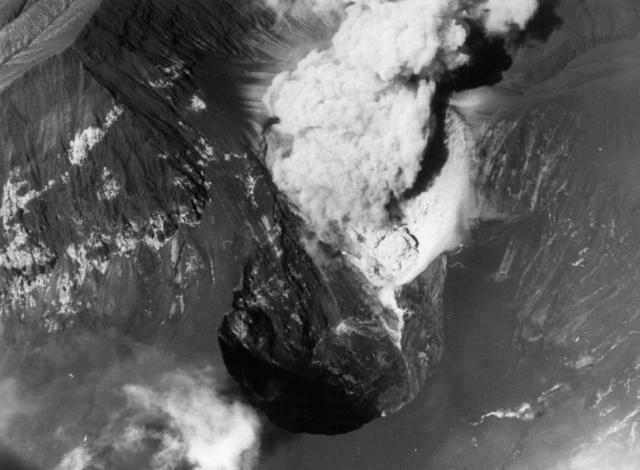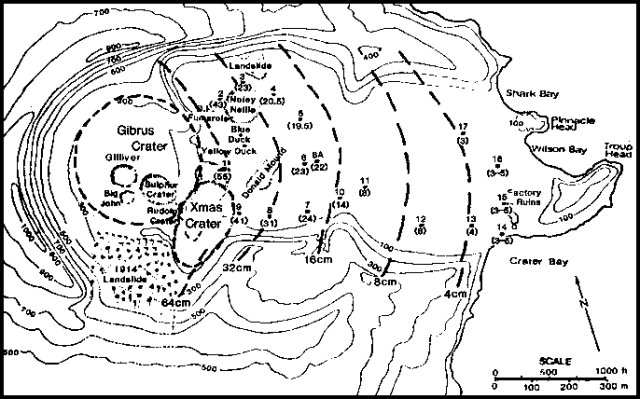Report on Whakaari/White Island (New Zealand) — February 1977
Natural Science Event Bulletin, vol. 2, no. 2 (February 1977)
Managing Editor: David Squires.
Whakaari/White Island (New Zealand) Vigorous eruptions through mid-February
Please cite this report as:
Global Volcanism Program, 1977. Report on Whakaari/White Island (New Zealand) (Squires, D., ed.). Natural Science Event Bulletin, 2:2. Smithsonian Institution. https://doi.org/10.5479/si.GVP.NSEB197702-241040
Whakaari/White Island
New Zealand
37.52°S, 177.18°E; summit elev. 294 m
All times are local (unless otherwise noted)
White Island was still erupting vigorously when visited on 25 January and inspected from the air on 12 February. The new crater (Christmas Crater) had increased slightly in size, but had not, as previously thought, engulfed Rudolf Crater.
25 January: Weak to moderate emission of ash in a moderately convoluting eruption cloud was occurring from a small vent (~10 m in diameter) within the new 160 m-diameter collapse crater (Christmas Crater). No incandescence was observed. Two scientists enveloped in the eruption cloud for about 30 seconds were covered by fine, dry ash and reported the cloud to be only "pleasantly warm". More than l m of fine- to moderate-grained tephra had been deposited on the E rim of Christmas Crater, but no large ejecta were observed. Noisy Nellie was much more active than on 13 December (02:01), emitting steam and SO2 under high pressure.
12 February: A dense buff-brown plume of convoluting steam and ash rose 600-750 m from a small vent near one wall of Christmas Crater (figures 2, 3, and 4). The eruption cloud was considerably darker than on previous inspections because of a higher ash content, and ash cover within the crater appeared much thicker than on 25 January. Christmas Crater had increased 10 m in diameter and was 100 m deep, with steep, buttressed walls and a generally flat floor. Slump blocks had collapsed into the crater and pools of discolored water were on its floor. Mudflows covered the steep slopes around the crater.
 |
Figure 2. Oblique aerial photo of Christmas Crater, 12 February 1977, showing steam and ash emission from the active vent. Courtesy of Ian Nairn. |
 |
Figure 3. Airphoto looking down into Christmas Crater, 12 February 1977, showing steam and ash emission from the active vent. Courtesy of Ian Nairn. |
Rudolf Crater was only a few meters deep, having been nearly filled with ash and slump debris. Noisy Nellie was steaming strongly, emission from Donald Mound was normal, and a little steam was issuing from the S wall of Gilliver. The crater floor around Noisy Nellie and Donald Mound was coated with sulfur.
Geological Summary. The uninhabited Whakaari/White Island is the 2 x 2.4 km emergent summit of a 16 x 18 km submarine volcano in the Bay of Plenty about 50 km offshore of North Island. The island consists of two overlapping andesitic-to-dacitic stratovolcanoes. The SE side of the crater is open at sea level, with the recent activity centered about 1 km from the shore close to the rear crater wall. Volckner Rocks, sea stacks that are remnants of a lava dome, lie 5 km NW. Descriptions of volcanism since 1826 have included intermittent moderate phreatic, phreatomagmatic, and Strombolian eruptions; activity there also forms a prominent part of Maori legends. The formation of many new vents during the 19th and 20th centuries caused rapid changes in crater floor topography. Collapse of the crater wall in 1914 produced a debris avalanche that buried buildings and workers at a sulfur-mining project. Explosive activity in December 2019 took place while tourists were present, resulting in many fatalities. The official government name Whakaari/White Island is a combination of the full Maori name of Te Puia o Whakaari ("The Dramatic Volcano") and White Island (referencing the constant steam plume) given by Captain James Cook in 1769.
Information Contacts: I. Nairn, NZGS, Rotorua; D. Shackelford, Villa Park, CA.


